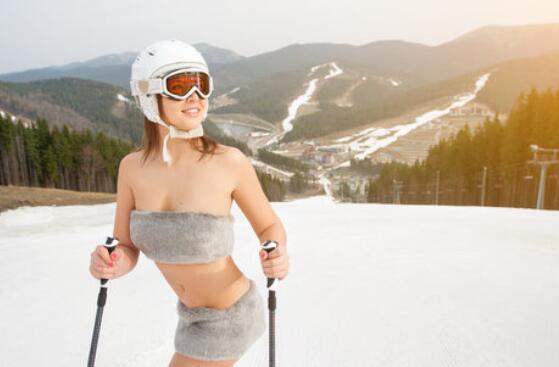Since you want to go for a dip in the snowy world, ski wear is naturally the most important prop. Ski clothing compared to the general ski jacket, waterproof performance requirements are higher, ski clothing design features are windproof, waterproof, and each layer is in the role of keeping the skier warm, dry and comfortable.
It is able to maintain the temperature, but also allows the skier's body moisture to quickly dissipate, which can greatly improve the skier's comfort and experience. And for beginners, who may often fall, wearing a ski suit does not have to worry about clothes getting wet.
How to choose ski clothing?
In order to better choose the right ski jackets for you, you need to have some essential knowledge. In addition to being stylish, ski wear should be warm, dry and able to maintain your comfort all day in the snowy mountains.
1.Ski clothing types
Before choosing the right ski wear, skiers should consider what kind of weather conditions they generally ski in. Will it be in a cold, dry climate or a ski resort with slightly higher temperatures and higher humidity? Some ski resorts can even have a variety of different temperatures and weather during the same week. However, one thing that is more important than external conditions is what environment your body is suited to. Do you tend to feel cold regardless of the weather? Or do you get hot and sweaty easily in cold weather?
Hard Shell VS Soft Shell VS 3-in-1
Different ski clothing has its own advantages
Hard shells
1. has a certain plastic feel
2. good water resistance
3. More protective
4. professional outdoor choice
5. Suitable for harsh environment
Softshell
1. Soft and more flexible
2. less waterproof
3. more focus on breathability
4. with some warmth
5. Suitable for daily or casual outdoor
Three in one
1. two-piece rash jacket
2. add down/down liner
3. usually detachable
4. Entry level
- 5. suitable for casual outdoor
The outer layer protects the skier from the weather and the inner layer keeps the skier warm, usually made of fleece or down. The inner and outer layers are perfectly combined with a zipper to provide a versatile combination of warmth and water resistance.
This type of ski jacket can be used both inside and outside, the outer layer can be used alone in spring and fall, and the inner layer can be used alone in the evening when going out for a walk, hence the name 3-in-1 ski jacket.
With a warm layer of snow clothing net weight, the material makes a big difference. There is usually a waterproof outer layer to keep dry, as well as down, down or synthetic materials such as ultra-soft water-repellent microfiber (Primaloft, commonly known as P cotton) made of warm layer, where the unit of measurement of warm material is grams, the greater the value, the warmer.
The design of the insulation layer adds additional warmth and allows for relatively greater mobility. These jackets can be worn inside ski jackets to increase warmth, but are not bulky at all. In addition, they are also popular to wear alone in spring and fall, and these jackets are usually made of fleece as a warming material.
Hardshell snowsuits have become increasingly popular in recent years and are among the most technical outdoor ski equipment for the general public. Hardshell snowsuits are generally windproof, waterproof and highly breathable, but do not have a warm layer. Hardshells are generally very lightweight, which improves their athletic performance. Since there is no warm layer, you can consider wearing another fleece jacket inside the hardsuit to keep warm.
Softshell snowsuits are made of softer and more flexible fibers. This type of snowsuit is one of the most breathable and windproof jackets, and they are perfect for wearing in spring and fall or separately, plus some designs are very stylish.
2.Model
fashion, looser, longer snowsuit
Snowboarding action range is large. Large action will often appear in the hand touching the snow action, rotating jump, I do not stop, but I also need to wear protective gear and so on, so wider.
The young people who play snowboard are more in line with the design of snowboard clothing more in line with the aesthetic requirements of young people, street style, there is another point is to take into account the protective gear, the top will be longer.
Ski jacket
Slightly slimmer, more practical
Compared to snowboard snowsuits, because both feet can move independently and faster, so the overall design of the double board snowsuit is also a little more snug, the upper body snowsuit is on the short side.
If you are participating in a speed competition, then low wind resistance is the most important. Tight-fitting snowsuit is, of course, the first choice.
If you are seeking to highlight your personal style and are not so demanding of high speed, then you can choose a more exaggerated style to highlight your personality.
The type of ski jackets you choose depends on your skiing style and personal preference.
Slim fit ski jackets has more cutouts on the shoulders, middle of the body and waist, but still maintains a good level of comfort.
The slim/standard fit allows you to keep up with fashion trends without feeling too tight, and the classic style with a slight cut improves comfort and movement.
Standard ski jackets is a relatively traditional style, generally designed to fit slightly lower on the waist, and is also a classic style that is not too tight.
The standard/loose fit ski jacket has a classic shape with plenty of room for additional warm layers and does not look bulky. If you want more movement and more space, then this is the perfect suit.
Loose fitting suits leave a lot of room in the shoulders and chest. Most freeride suits fall into this category.
3. Waterproof index
Snowboard jackets
Needs higher waterproofing, especially for snow pants
Snowboarders often sit on the snow while shoeing at the top of the mountain and when resting in the piste, it is important that snowboarding pants are waterproof. It's also because snowboarders are more prone to falling when skating than double boarding, so the waterproofing of the pants needs to be better than double boarding snowsuits.
Ski Jacket
Smaller capacity and less waterproof than snowboard
Ski jackets for snowboarding are more slim-fitting, so the capacity is smaller. The double-board feet can move separately, so the possibility of falling is very small, and basically there is not much chance of close contact with the piste, so it does not matter if the waterproof performance is poor.
The waterproof index of ski clothing determines how quickly it is saturated with moisture and how quickly water penetrates the clothing. Simply put, the waterproof index refers to the ability of the clothing to stay dry in a humid environment, and the higher the waterproof index, the longer the clothing stays dry in a humid environment. The waterproof index is measured in millimeters. It is usually considered that when a 10,000mm high column of water is pressed on top of the fabric and no more than 3 drops of water seeps out from the fabric within 24 hours, then we consider the waterproof index of the garment to be 10,000mm, and the higher the waterproof index, the more waterproof the garment is.
There are various types of waterproof fabrics used to make ski wear, the most famous of which are Gore-Tex, Hyvent and Event. The superior waterproof performance of these materials comes from their surface pores, which are smaller than water molecules and larger than water vapor molecules, making these materials both waterproof and breathable.
Super high waterproof index (>20001mm)
Indicates that this type of jacket is the best choice for warmth and waterproofness. In addition, thanks to the combination of the best waterproof fabric and super waterproof (DWR) coating, this type of jacket can keep you dry all day long, whether it is a heavy snowfall or a sudden medium rain.
High Waterproof Index (15001-20000mm)
Snowsuits are suitable for skiers who need to fight against different weather conditions and stay dry in heavy snow and heavy rain conditions.
Medium waterproof index (10001-15000mm) snowsuit is the most common. It also uses super waterproof coating with waterproof fabric to keep skiers dry all day in light to medium snow or light rain conditions.
Normal waterproof index (5001-10000mm) snowsuits also use super waterproof coating and waterproof fabric, which can keep skiers dry in light snow or light rain.
Lightly waterproof (<5000mm) jackets use only a waterproof coating, which allows you to stay dry in light snow conditions, but will quickly absorb water and become wet when it rains.
Unspecified type of jacket means that the manufacturer's catalog states that this type of jacket is a waterproof jacket, but does not provide the relevant specific parameters.
Non-waterproof jackets are jackets that do not have any waterproof treatment and are usually used in spring and fall, or worn as a warm layer under a waterproof jacket.
4. Warmth Rating
When it comes to the warmth rating of ski clothing, you need to consider whether you will easily feel hot or cold during the skiing process.
Non-warm jackets called ski jackets are mainly used to resist bad conditions while also providing a minimum level of warmth. Ski jackets sacrifice warmth to improve movement and weather protection. If you choose a ski jacket, please properly equip it with wicking layers and warm layers for different temperature conditions.
A lightly insulated jacket is ideal for skiing in relatively warm temperatures, and a thermal layer with a wicking layer is recommended for colder times or windy conditions.
Warm jackets are suitable for normal colder weather. If you don't feel too cold in normal winter, then a warm jacket is enough to ensure you ski comfortably in the snowy mountains. In addition, a wicking layer is beneficial for moisture management and can help you stay warm and dry at all times, especially in extremely cold conditions or when it is easy to feel cold, it is recommended to add a few additional layers.
Warmer jackets often use down or synthetic materials as insulation. These materials confine heat to the inside of the garment and therefore keep it warm during extended periods of cold. In addition, the perspiration layer is good for moisture management, but the middle layer or insulation layer can sometimes make people feel stuffy.
The warmest jackets have an insulation structure with additional insulation properties that retains heat and creates an insulating layer to combat extreme cold, and a wicking layer is recommended for moisture management. This type of jacket is ideal for skiers who are brave enough to take on extreme cold weather, sometimes even defying the polar vortex.
5. Breathability
Breathability indicates how efficiently a garment can transfer water vapor or sweat to the outside. The pores in the garment prevent water from penetrating while allowing water vapor molecules to diffuse outward, which keeps you dry and warm.
Breathability is measured in grams and is expressed by the moisture vapor permeability rate (MVTR). Moisture vapor permeability refers to how much of a cubic meter of water can diffuse through a garment in a 24-hour period. The greater the permeability, the more moisture can diffuse out, the more breathable the clothing is. Highly breathable clothes can provide you with a comfortable temperature for a long time.
Ultra-high breathability (>20001g)
The jacket can keep you dry and comfortable in any environment, and you won't feel stuffy and uncomfortable even after a full day of heavy exercise.
High breathability (15001-20000g)
Snowsuit is very suitable for skiers who keep sweating for a long time, and high breathability can keep them dry all day.
Medium breathability (10001-15001g)
Jackets are most popular among the public due to their superb cost performance. These jackets allow you to stay dry and comfortable during moderate exercise, and can easily handle short periods of intense exercise.
Normal breathability (5001-10000g)
Jackets can provide enough breathability to stay comfortable under a full day of low to moderate intensity exercise or a short period of high intensity exercise. But under longer, high-intensity exercise, you will sweat profusely without the aid of other layering.
Low breathability (<5000g)
The lower breathability of the jacket will make you sweat a lot under medium to high intensity exercise, and you will gradually feel cold when you stop exercising.
Unspecified type of jacket indicates that the material used has not been tested for breathability, or is not indicated by the manufacturer. Commonly found in casual or fleece jackets.
6. Warm layer material
Down is a natural warming material with a high warmth-to-weight ratio. Although jackets with high down content can look bulky, they are also the warmest jackets. Jackets with low down content have a very good fit, but the only drawback is that they are not very waterproof.
The fleece combines the advantages of both light weight and warmth and can be worn both inside and on its own.
No warmth means that some jackets do not contain any warming material. This type of design is usually found on hardshells with the best waterproof and breathable properties. Skiers should have a separate wicking or warming layer, or both, under such a hard shell.
Synthetic insulation is the most common material. Their brand names are usually similar to Thinsulate or Primaloft, etc. Even if they are soaked, the synthetic material layer will act as a warmth retainer.
7. Thread Seam
The seam allowance sealed by partial pressure glue is the seam allowance located in the shoulder or shoulder area that is protected from moisture penetration by the pressure glue process. Seam allowances sealed with pressed glue are sufficient to protect from moisture as long as the seam allowance is not constantly exposed to wet conditions or lying in the snow.
Seam openings sealed with all pressed glue are those where, in order to obtain additional waterproofing, a layer of waterproofing glue is applied to the inside and outside of all pressed glue seam openings, thus protecting the areas where moisture can easily penetrate. Fully glued seams are especially suitable for extreme weather conditions such as heavy snowfall.
8. Other
ski jackets with hoods: Most snowsuits are equipped with hoods, which provide additional protection for skiers, and most hoods can be worn directly over the helmet without interfering with vision.
The non-removable hood is by far the most common design and is an integral part of the ski suit.
Removable hoods: Underarm zippers/ventilation zippers are very important for ski clothing to regulate the temperature inside the clothing. Underarm zippers can be opened to cool down when you feel hot during the skiing process, and some ski suits also offer other forms of ventilation zippers, such as those located on the chest.
Finger guards are located in the cuff lining and cover the hands, but expose the fingers. Finger guards are usually sewn into the inside of the cuff to keep the cold air from seeping in and keeping the temperature down even after the gloves are taken off. Finger guards are very warm and are usually found in women's ski jackets or children's ski jackets.
Snow skirt is a necessary structure of the ski suit, sewn at the waist of the ski suit, and installed with zippers or buttons, so that the snow suit and snow pants will be separated from each other, helping to prevent snow and cold wind from entering clothes, especially in the fall. The snow is not easy to enter the interior of the snow suit.
Ski clothing selection advice
1. Waterproof ability: ski wear is recommended to choose more than 10000mm waterproof material, basically you can meet most of the needs. Like 20000mm is wild snow, rain and snow and other scenes used.
2. Breathability: breathability refers to the quality of water vapor transmission in a certain relative temperature difference, a certain thickness, 1 square meter area film in 24h. Ski wear is recommended to choose more than 5000g breathable material, otherwise it will be stuffy sweat easily to catch a cold.
3. warmth: warm layer can choose to use synthetic warm material ski clothing. Afraid of cold can choose to add cotton snow clothing, it is not recommended to wear down directly, because down is static.
SkiVigor ski jacket ski jackets ski clothing ski wear Ski Coat ski suit ski equipment lightweight ski jacket Snow Jacket ski clothes women's ski jacket outdoor ski equipment outdoor gear Ski clothes Winter ski coat Ski Cothing Mall Color block Ski Jacket Women's snowboarding jacket men's ski jacket skiing Equipment shell ski jackets men’s ski jacket snowboard jacket ski jacket for women snowboard jackets ski sets ski equipments Ski clothing mall Ski Wear 3-in-1 ski jacket skiing equipment ski pants skiwear
is gemyse a good brand best ski jacket companies gemyse brand ski jacket vs parka difference between ski and snowboard jacket difference between alpine and nordic skiing




